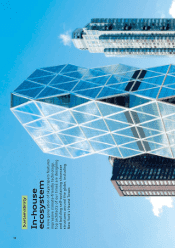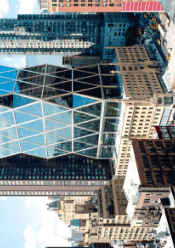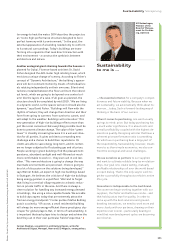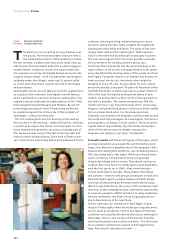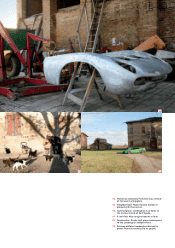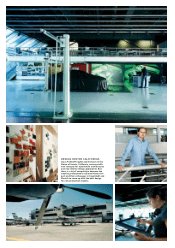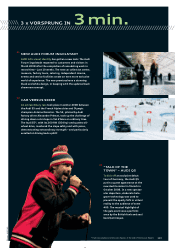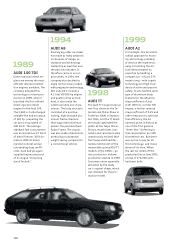Audi 2008 Annual Report Download - page 111
Download and view the complete annual report
Please find page 111 of the 2008 Audi annual report below. You can navigate through the pages in the report by either clicking on the pages listed below, or by using the keyword search tool below to find specific information within the annual report.
108
I
I
m
m
a
a
g
g
i
i
n
n
a
a
t
t
i
i
o
o
n
n
In the land of ideas
What do Munich, Ingolstadt and Los Angeles all have in common? All have designers
hard at work designing future Audi models. While the vast majority of creative minds
at corporate headquarters are working on tomorrow’s cars, the studios in Munich and
Los Angeles are developing mobility concepts for the less immediate future.
rent trends are discussed – whether it
is the latest Hollywood high-tech car-
toon or even a child’s toy. Creative
people are always on the lookout for
new ideas, and anyone working here
is also getting paid to break down bar-
riers in their own heads and let their
imaginations run wild. At times, that
can also mean trying out other prod-
ucts like high-tech skis, a tabletop
soccer game or even a concert piano.
Setting up the studio in the center of
Schwabing was a deliberate choice.
Not only does the trendy neighbor-
hood have a disproportionate number
of convertibles and sports cars, there
is no shortage of classic and vintage
cars and, of course, those of the com-
petition. “It’s extremely important to
experience our own automobiles in
the same frame of reference as other
vehicles, and to see how they move
through traffic,” explains Monnerjan.
But that’s not the only thing that
makes Munich such an interesting lo-
cation for a design studio. The streets
are pulsating with life. The university
and the huge English Garden, Munich’s
Central Park, are just around the cor-
ner. Not only are trends recognized
and adopted early in the Bavarian capi-
tal, sometimes they are even set here.
But how can these creative brains take
such abstract thoughts and convert
them into concrete forms? “We get
our inspiration from our environs,”
says Christian Labonte, responsible
nippets of English, Italian and
Spanish dart through the air.
There is a smell of resin and
clay, the components of industrial
plasticine, the modeling clay used to
hand-sculpt tomorrow’s dream cars.
At the moment, three clay models are
covered by tarps in the loft-like work-
shop with the modelers’ sculpting
tools close at hand. Carsten Monner-
jan, Head of Concept Design Munich,
asks visitors for their understanding:
“Everything here is top secret!”
For 25 years, Audi Design has oper-
ated a branch office in the vibrant city
of Munich. Far enough away from
corporate headquarters in Ingolstadt
to allow the designers to work more
independently – and more unconven-
tionally – but close enough so that
Audi Group design chief Wolfgang
Egger can occasionally drop by the
Schwabing studio to discuss the sta-
tus and results of projects with his
staff. “This is where the trouble mak-
ers are,” explains Egger with a smile.
“In Ingolstadt, the designers work in
close proximity to the engineers and
production, which exposes them to
different influences and keeps them
close to the production model.”
The Munich designers, on the other
hand, have more freedom to think be-
yond the narrow confines of manufac-
turing and work on new vehicle cate-
gories. That’s also the reason why the
company decided in 1984 that design
shouldn’t just take place in Ingolstadt.
A workshop large enough to create
full-scale models is only one part of
the studio. There’s also a large atelier
where interior and exterior designers
sit at their computers, discussing the
contour of rooflines, wheel wells and
headlights. A front wall made of
glass bricks lets plenty of daylight
into the room. But anyone outside
expecting to find a trendy glass
palace here is going to be sorely
disappointed. An inconspicuous
gateway leads to a rear building in
Munich’s Schwabing district and a
back courtyard with a long auto-
motive tradition. Since the 1930s,
auto mechanics have been repairing
all types of cars in the “Kurfürsten-
garage Schwabing.” There was even a
filling station. The old garage sign
now hangs in the modeling hall.
14 designers, assisted by model mak-
ers and modelers, work here in tight
quarters. The confusion of languages
sometimes reaches Babylonian pro-
portions: This is an international team
which has grown more and more in
recent years, and the studio space is
slowly being pushed to its limits.
The heart of communication is lo-
cated in the shop kitchen, which dou-
bles as a conference room and sepa-
rates the studio from the workshop.
This is where ideas are shared and cur-
Copy Titus Arnu, Jochen Siegle
Photos Piet Truhlar, Frank Kayser
S


